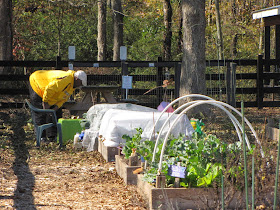 |
| Green Meadows Early November 2013! |
- Advective frost - is the condition where a sudden cold front sweeps into the area with gusty winds and immense cloud cover. The layer of cold air is so thick and dense; it can actually reach as much as a mile high. Rarely will we see a first frost event under these conditions, but it can happen.
- Radiation frost - is the type of frost event most common to our area and the one we mainly think of. The nights have little to no wind, skies are clear, and the stars are simply beautiful for gazing.
Frost protection works as an insulator to protect plants from the harmful effects of the event. The protection is valuable to the veggie gardener in two different ways.
- It protects plants from the effects of frost on their leaf surfaces that frequently leads to damage within the cell and tissue structures. This is most often damage that is beyond repair, resulting in permanent injury at growth points, wilting, and potential death to the vegetable.
- The protection also works as an insulator to hold on to your ground temperatures by creating a micro-climate within your bed. Keeping the ground temperatures up allows your plants to continue their growth and production cycles for an extended period. All plants will eventually reach a point of hibernation and overwinter. However, the more growth that the plant has, the greater harvest a gardener can achieve through this period of rest.
Green Meadows Healthy Garden Tips for Success During Frost Events:
- Harvest early - warm season vegetables are the most sensitive to frost events and the time has come to go ahead and harvest what you have left. The texture and flavor in these crops will dramatically fall off with an extended cold period even if you cover.
- Know the cold tolerance of your plants - all cool weather vegetables have different tolerances to frost and cold weather. As an example, many of the brassica's are at their peak flavor when you allow frost to reach them, however, if you have any peas producing; it is wise to harvest. While the pea plants are very tolerant to cold and mild frost events, the pods are not. Cell structures can burst within the pod itself and ruin the texture and flavor. Vicki and I have learned this lesson the hard way several times.
- Irrigate before the frost event - irrigating before the frost event arrives builds much needed moisture into the soil. Moist soil will hold the heat as much as four times greater than dry soil according to several published university studies. One study even shows that the increased air temperature, right above the soil level, was still five degrees warmer than dry soil at 6:00 am the next morning when watered the evening prior. This can be the difference between having plants with damage and having plants without. For those that are covering, it is important to water late the day of the event, but still allow the leaves to dry before erecting your frost protection.
- Cover your plants - using frost blankets can provide several degrees of additional warmth to plants. While the covers can be laid directly on the plants, this method provides the least amount of protection and the greatest risk of still receiving injury from the cold. Any material can really be used to cover your plants, although you will find your best protection comes from woven fabrics. Plastics should be avoided if at all possible as they tend to do more harm than good unless using those specifically geared for vegetable growing. Remember to vent your structures in order to keep plants from overheating when the temperatures start to rise above 45 - 50 degrees.
- Irrigate during the event - this is actually a trick that Mike would use now and then if he were unable to get over and cover in the evening. Rinsing the frost off early in the morning before it has a chance to penetrate the plant's cell structures is a method that some tend to use. This can work for very light frosts in the 32-degree range if done right before sunrise. Rinsing the plants with water during the event keeps their internal temperatures from freezing and prevents the cold damage to cell structure and tissues. However, with that being said, frosts occurring at lower temperatures would need several applications throughout the night or a system of overhead irrigation that you would see among professional growers.
 |
| Mr. Wesley checking his cover! |
If you need any help preparing for the cold spell, please don't hesitate to ask. I am attaching this link as a very basic article from Botanical Interests that shows the frost tolerance of many vegetables. It gives you a brief overview of what can tolerate what temperature alongside some other very important factors.
https://botanicalinterests.com/articles/view/26/Frost-Tolerance-of-Vegetables - link to the frost tolerance of vegetables from Botanical Interests.
Happy Gardening,
Denise, Beds 25 & 29

No comments:
Post a Comment